Articles
- Page Path
- HOME > J Korean Acad Community Health Nurs > Volume 25(4); 2014 > Article
-
Original Article
- Gender Differences in Factors Influencing The Framingham Risk Score-Coronary Heart Disease by BMI
- Kwang-Ok Park, Ji-Yeong Seo
-
Journal of Korean Academy of Community Health Nursing 2014;25(4):248-258.
DOI: https://doi.org/10.12799/jkachn.2014.25.4.248
Published online: December 31, 2014
Department of Nursing, Catholic University of Pusan, Busan, Korea.
© 2014 Korean Academy of Community Health Nursing
This is an Open Access article distributed under the terms of the Creative Commons Attribution Non-Commercial License (http://creativecommons.org/licenses/by-nc/3.0/) which permits unrestricted non-commercial use, distribution, and reproduction in any medium, provided the original work is properly cited.
- 925 Views
- 3 Download
- 10 Crossref
Abstract
-
Purpose
- This study was to investigate factors influencing the Framingham risk score-Coronary heart disease (FRS-CHD) according to gender and body mass index (BMI) of adults who participated in the 5th Korea National Health and Nutrition Examination Survey (KNHANES V-3).
-
Methods
- This study used a cross-sectional design with secondary analysis with KNHANES V-3. The FRS-CHD scores were measured with ages, sex, blood pressure, cholesterol, high density lipoprotein, smoking, and diabetes mellitus. With demographic characteristics, family history of ischemic heart disease, types (intensity) and days of physical activities, perceived stress, drinking, menopause (in female), and BMI scores were measured. The data were analyzed with descriptive statistics, Pearson's correlation coefficients, and multiple regressions.
-
Results
- FRS-CHD was significantly associated with types (intensity) and days of physical activities, educational level, occupation, and marital status, explaining 19.1~76.8% of the variance in men. FRS-CHD was significantly associated with types (intensity) and days of physical activities, menopause, and education level, explaining 55.0~59.5% of the variance in women.
-
Conclusion
- Factors influencing FRS-CHD were significantly different according to gender and BMI. To reduce the risk of coronary artery disease, it is necessary to develop gender-specific physical activity programs according to BMI.
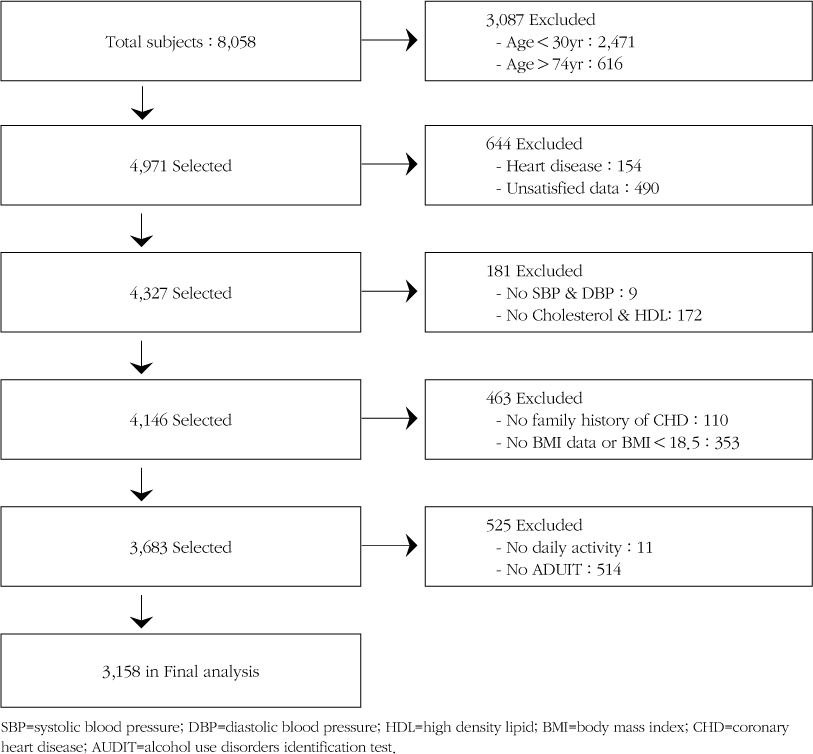
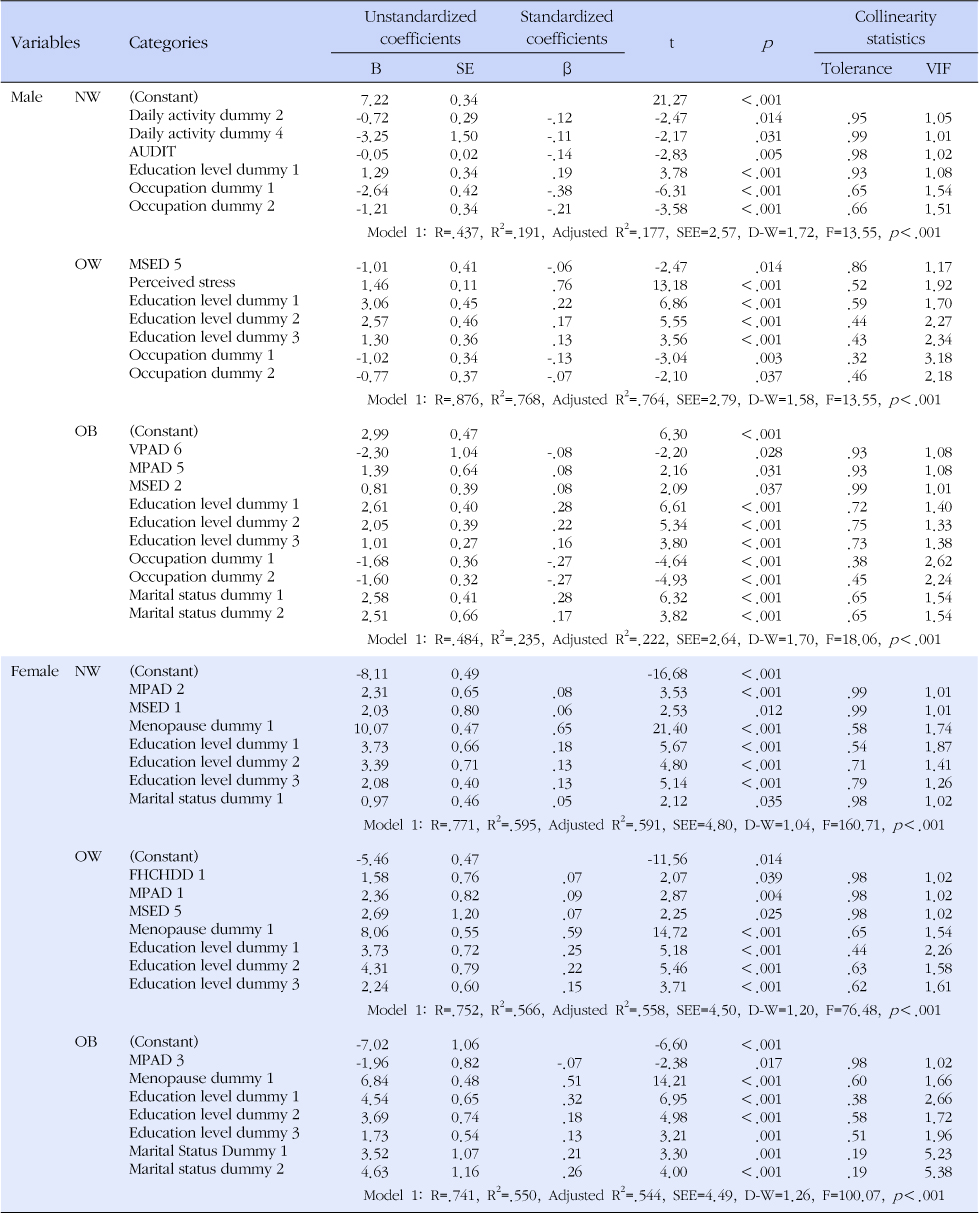
SE=Standard error; NW=normal body weight; OW=over-weight; OB=obesity; AUDIT=Alcohol use disorders identification test; MSED=Muscle strength exercise dummy; VPAD=Vigorous physical activity dummy; MPAD=Moderate physical activity dummy; FHCHDD=Family history of coronary heart disease dummy; SEE=Standard error of the estimate; D-W=Durbin-Watson.
-
This paper was supported by RESEARCH FUND offered from Research Institute of Nursing Science, Catholic University of Pusan, 2012.
NOTES
- 1. Statistics Korea. The statistical result about cause of death at 2012 [Internet] Seoul: Statistics Korea; 2013;cited 2014 August 5. Available from: http://www.index.go.kr/potal/main/EachDtlPageDetail.do?idx_cd=1012
- 2. In: Mendis S, Puska P, Norrving B, editors. Global Atlas on cardiovascular disease prevention and control. Geneva: World Health Organization in collaboration with the World Heart Federation and the World Stroke Organization; 2011.
- 3. American Heart Association. Coronary artery/heart disease [Internet] Dallas: American Heart Association; 2014;cited 2014 August 5. Available from: http://www.heart.org/HEARTORG/Conditions/More/MyHeartandStrokeNews/Coronary-Artery-Disease---Coronary-Heart-Disease_UCM_436416_Article.jsp
- 4. Framingham Heart Study. A project of the national heart, lung, and blood institute and Boston University [Internet] Framingham: Framingham Heart Study; 2014;cited 2014 June 14. Available form: http://www.framinghamheartstudy.org/about-fhs/history.php
- 5. Wilson PW, D'Agostino RB, Levy D, Belanger AM, Silbershatz H, Kannel WB. Prediction of coronary heart disease using risk factor categories. Circulation. 1998;97(18):1837–1847. http://dx.doi.org/10.1161/01.cir.97.18.1837Article
- 6. Murray CJ, Lauer JA, Hutubessy RC, Niessen L, Tomijima N, Rodgers A, et al. Effectiveness and costs of intervention to lower systolic blood pressure and cholesterol: A global and regional analysis on reduction of cardiovascular-disease risk. Lancet. 2003;361(9359):717–725. Cited by Choi EH, Seo JY. Framingham risk score by general characteristics and physical activity: Based on the 4th Korean national health and nutrition examination survey. Korean Public Health Research. 2011;37(1):85-96
- 7. Framingham Heart Study. Risk score profile [Internet] Framingham: Framingham Heart Study; 2014;cited 2014 May 23. Available form: http://www.framinghamheartstudy.org/risk-functions/index.php
- 8. Fletcher GF, Blair SN, Blumenthal J, Caspersen C, Chaitman B, Epstein S, et al. Statement on exercise: Benefits and recommendations for physical activity programs for all Americans. A statement for health professionals by the committee on exercise and cardiac rehabilitation of the council on clinical cardiology, American Heart Association. Circulation. 1996;94(4):857–862. http://dx.doi.org/10.1161/01.cir.94.4.857Article
- 9. Strath SJ, Swartz AM, Bassett DR Jr, O'Brien WL, King GA, Ainsworth BE. Evaluation of heart rate as a method for assessing moderate intensity physical activity. Med Sci Sports Exerc. 2000;32:9 Suppl. S465–S470. http://dx.doi.org/10.1097/00005768-200009001-00005Article
- 10. World Health Organization Western Pacific Region. Pacific physical activity guidelines for adults. Framework for accelerating the communication of physical activity guidelines [Internet] World Health Organization Western Pacific Region: WHO; 2008;cited 2014 January 13. Available from: http://www.who.int/dietphysicalactivity/publications/pacific_pa_guidelines.pdf
- 11. Warburton DER, Katzmarzyk PT, Rhodes RE, Shephard RJ. Evidence-informed physical activity guidelines for Canadian adults. Can J Public Health. 2007;98:Suppl 2. S16–S68. http://dx.doi.org/10.1139/H07-123
- 12. Maeda S, Miyauchi T, Goto K, Matsuda M. Alteration of plasma endothelin-1 by exercise at intensities lower and higher than ventilatory threshold. J Appl Physiol (1985). 1994;77(3):1399–1402. Article
- 13. Maeda S, Miyauchi T, Sakane M, Saito M, Maki S, Goto K, et al. Does endothelin-1 participate in the exercise-induced changes of blood flow distribution of muscles in humans. J Appl Physiol (1985). 1997;82(4):1107–1111. Article
- 14. Whitlock G, Lewington S, Sherliker P, Clarke R, Emberson J, Halsey J, et al. Body-mass index and cause-specific mortality in 900,000 adults: Collaborative analyses of 57 prospective studies. Lancet. 2009;373(9669):1083–1096. http://dx.doi.org/10.1016/s0140-6736(09)60318-4Article
- 15. Gelber RP, Gaziano JM, Orav EJ, Manson JE, Buring JE, Kurth T. Measures of obesity and cardiovascular risk among men and women. J Am Coll Cardiol. 2008;52(8):605–615. http://dx.doi.org/10.1016/j.jacc.2008.03.066Article
- 16. Arnlov J, Ingelsson E, Sundstrom J, Lind L. Impact of body mass index and the metabolic syndrome on the risk of cardiovascular disease and death in middle-aged men. Circulation. 2010;121(2):230–236. http://dx.doi.org/10.1161/circulationaha.109.887521Article
- 17. Zheng W, McLerran DF, Rolland B, Zhang X, Inoue M, Matsuo K, et al. Association between body-mass index and risk of death in more than 1 million Asians. N Engl J Med. 2010;364(8):719–729. http://dx.doi.org/10.1056/nejmoa1010679
- 18. Romero-Corral A, Montori VM, Somers VK, Korinek J, Thomas RJ, Allison TG, et al. Association of bodyweight with total mortality and with cardiovascular events in coronary artery disease: A systematic review of cohort studies. Lancet. 2006;368(9536):666–678. http://dx.doi.org/10.1016/s0140-6736(06)69251-9Article
- 19. Choi MC, Song YH, Lee SY, Woo JT. Framingham risk scores by occupational group: Based on the 3rd Korean national health and nutrition examination survey. Korean J Occup Environ Med. 2009;21(1):63–75. ArticlePDF
- 20. Yang IS, Choi DH, Kang YH. The awareness of cardiovascular risk factors and its correlates in patients with coronary artery diseases. J Korean Acad Adult Nurs. 2010;22(5):499–508.
- 21. Bigert C, Gustavsson P, Hallqvist J, Hogstedt C, Lewne M, Plato N, et al. Myocardial infarction among professional drivers. Epidemiology. 2003;14(3):333–339. http://dx.doi.org/10.1097/01.EDE.0000057141.91012.80Article
- 22. Kim KA, Kim JS, Kim MS. Predictors of coronary heart disease risk in healthy men and women. J Korean Acad Nurs. 2007;37(7):1039–1048. ArticlePDF
- 23. Gill T. Epidemiology and health impact of obesity: An Asia Pacific perspective. Asia Pac J Clin Nutr. 2006;15:Suppl. 3–14.
- 24. Smart N, Marwick TH. Exercise training for patients with heart failure: A systematic review of factors that improve mortality and morbidity. Am J Med. 2004;116(10):693–706. http://dx.doi.org/10.1016/j.amjmed.2003.11.033Article
- 25. Choi EH, Seo JY. Framingham risk score by general characteristics and physical activity: Based on the 4th Korean national health and nutrition examination survey. Korean Public Health Res. 2011;37(1):85–96.
- 26. Park SH, Kang YH, Park HY. Alcohol consumption and the coronary heart disease-related risk factors in Korean adults: The third Korea National Health and Nutrition Examination Survey (KNHANES III), 2005. Korean J Nutr. 2008;41(3):232–241.
- 27. Agarwal DP. Cardioprotective effects of light-moderate consumption of alcohol: A review of putative mechanisms. Alcohol Alcohol. 2002;37(5):409–415. Cited by Park SH, Kang YH, Park HY. Alcohol consumption and the coronary heart disease- Related risk factors in Korean adults: The third Korea National Health and Nutrition Examination Survey (KNHANES III), 2005. Journal of Nutrition and Health. 2008;41(3):232-241Article
Figure & Data
References
Citations

- Analysis of Influencing Factors of Heart Disease
Shuyi Li
Highlights in Science, Engineering and Technology.2023; 61: 133. CrossRef - Cow’s Milk Intake and Risk of Coronary Heart Disease in Korean Postmenopausal Women
Ae-Wha Ha, Woo-Kyoung Kim, Sun-Hyo Kim
Nutrients.2022; 14(5): 1092. CrossRef - Sex differences in the relationship between depression and cardiovascular disease risk: a nationwide study in Korea
Seol-bin Kim, Ihn Sook Jeong
Osong Public Health and Research Perspectives.2021; 12(2): 105. CrossRef - Body Fat Distribution and Associated Risk of Cardiovascular Disease in Adults With Cerebral Palsy
Hyun Iee Shin, Se Hee Jung
Frontiers in Neurology.2021;[Epub] CrossRef - Comparing Framingham risk score and cognitive performance in a Mexican American cohort
Raul Vintimilla, Kishore Balasubramanian, James Hall, Leigh Johnson, Sid O Bryant
Aging and Health Research.2021; 1(4): 100041. CrossRef - Lifestyle and Quality of Life in Patients with Coronary Artery Disease: A Propensity-Matched Comparison with a Healthy Control Group
Seong Hui Choi, Seon Young Hwang
Korean Journal of Adult Nursing.2020; 32(2): 199. CrossRef - Factors related to Coronary Artery Disease in Korean Adults: Based on the Korean National Health and Nutrition Examination Survey 2013~2015
Sook Young Kim
The Korean Journal of Rehabilitation Nursing.2018; 21(1): 33. CrossRef - Identifying Latent Classes of Risk Factors for Coronary Artery Disease
Eunsil Ju, JiSun Choi
Journal of Korean Academy of Nursing.2017; 47(6): 817. CrossRef - The Assessment of Framingham Risk Score and 10 Year CHD Risk according to Application of LDL Cholesterol or Total Cholesterol
Se Young Kwon, Young Ak Na
Korean Journal of Clinical Laboratory Science.2016; 48(2): 54. CrossRef - Body Mass Index, Anthropometric Factors, and Food and Nutrient Intakes of Korean Middle-Aged Males by Year : Based on 2001~2011 Korea National Health and Nutrition Examination Survey (KNHANES)
Soon-Nam Choi, Kwang-Hyun Jho, Nam-Yong Chung
Journal of the Korean Dietetic Association.2016; 22(2): 88. CrossRef

 KACHN
KACHN
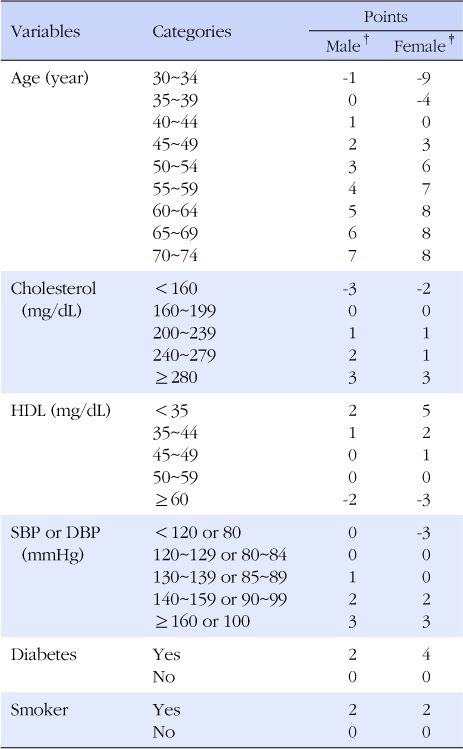
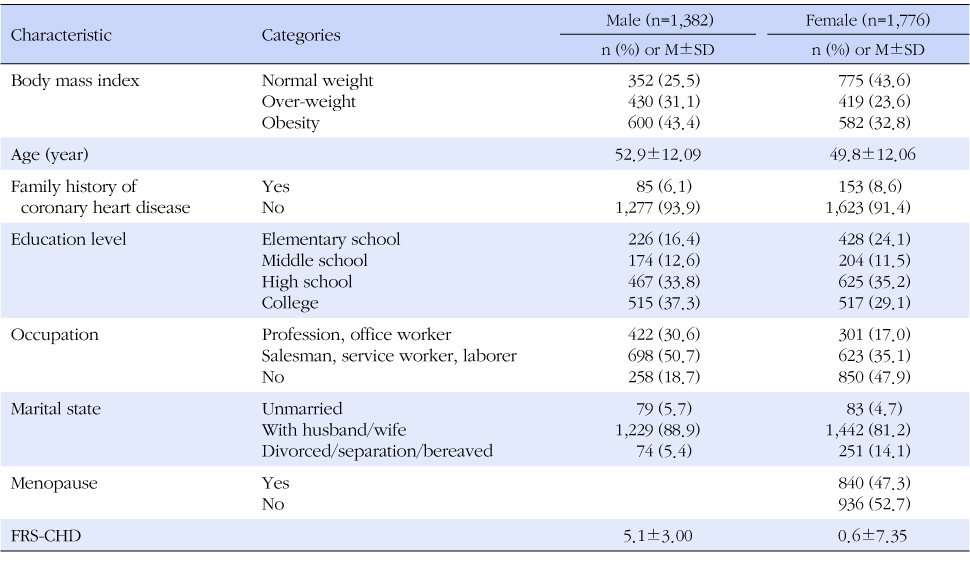
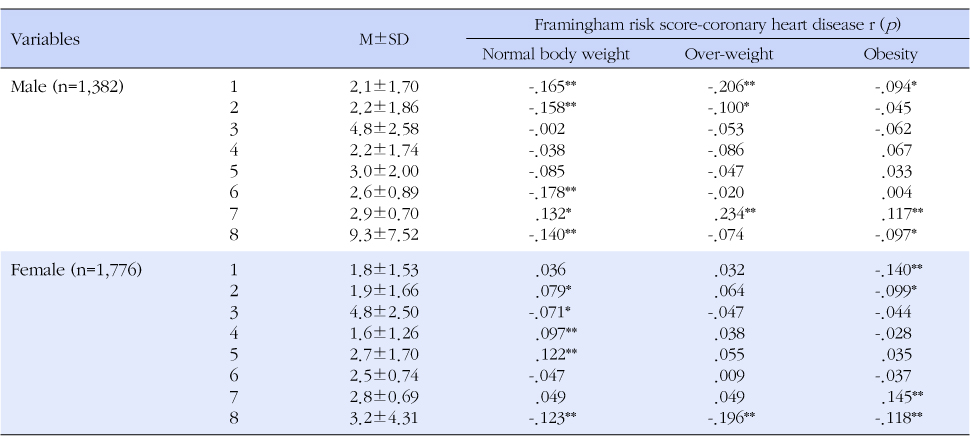

 PubReader
PubReader Cite
Cite


